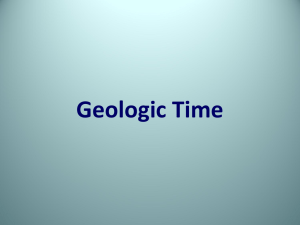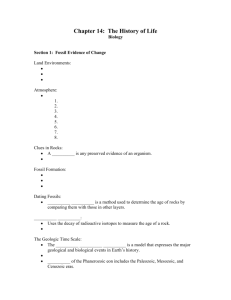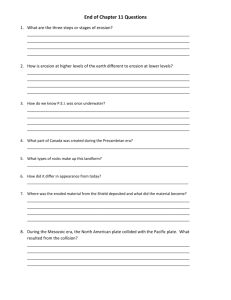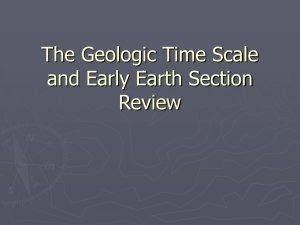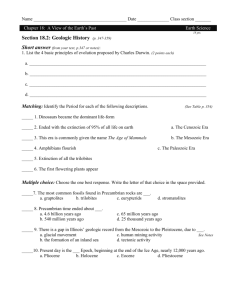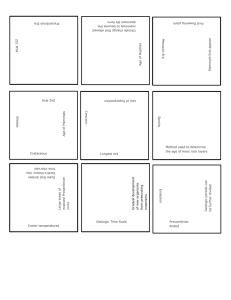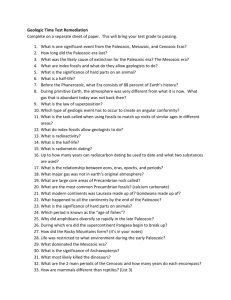Geologic Time Scale
advertisement
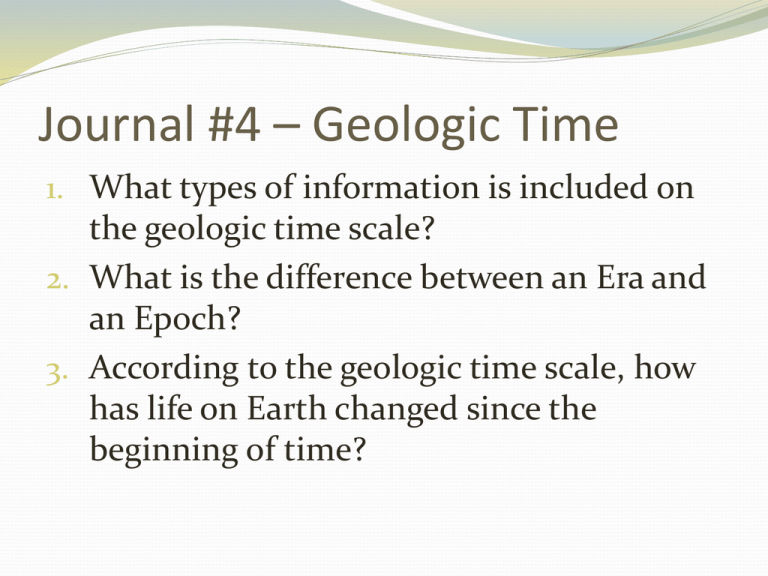
Journal #4 – Geologic Time 1. What types of information is included on the geologic time scale? 2. What is the difference between an Era and an Epoch? 3. According to the geologic time scale, how has life on Earth changed since the beginning of time? Objective: Understanding the events of Earth’s past and how they are organized into a chart. Geologic Time Organic Evolution The change in life-forms through time Species A group of organisms that normally reproduce only with themselves Species 2 Different Species Breed Offspring unable to reproduce Adaptation Adaptation The ability to change to survive Ex. Light colored peppered moths camouflaged on light tree bark; pollution causes them to change to darker colors to survive Ex. Galapagos finches and their beaks Natural Selection Natural Selection Organisms with traits that are suited to a certain environment have a better chance of surviving and reproducing 1836 by Charles Darwin Evolution Main Causes of Evolution Changes to the environment Caused by plate tectonics Competition with others for resources Endangered vs. Extinct Endangered When only a small number of members are living Extinct When none of its members are living Extinction Human Contribution to Extinction Destruction of habitats Competition for same food supply Overhunting Geologic Time Geologic Time Scale A record of Earth’s history that shows events of life, earth processes, time units and ages Divided into smaller units based on Types of life-forms living at that time Geologic events occurring at that time Geologic Time Eras • Largest • Based on lifeforms and fossil evidence Periods • Divide Eras • Based on lifeforms and geologic events Epochs • Smallest • Divide Periods Geologic Time Precambrian Longest geologic time unit in Earth’s history Began: 4600 million years ago (4.6 billion years) Ended: 540 million years ago Precambrian Precambrian Fossils Limited Rocks deeply buried or eroded Rocks have been changed by heat and pressure Early organisms were soft-bodied Early organisms were small and single-celled Cyanobacteria Cyanobacteria Bacteria and algae combine and photosynthesize to form stromatolites Appeared: 3.5 billion years ago Take in CO2, Release O2 Cyanobacteria Cyanobacteria Importance: changed Earth’s atmosphere by adding free oxygen to the air Formed the ozone layer protecting organisms from UV light Single-celled organisms evolved into complex organisms Invertebrate Invertebrate Animal without a backbone Appeared: end of the Precambrian Ex. Jellyfish, sponges, worms Paleozoic Era Paleozoic Era “Ancient Life” Beginning marked by the development of hard parts Began: 540 million years ago Ended: 245 million years ago Paleozoic Era Paleozoic Era Abundant Life: ocean dwelling marine organisms Caused by warm, shallow seas covering most of earth Appeared: Cambrian Period Ex. Trilobites, brachiopods, cephalopods, crinoids Paleozoic Era Animals Vertebrate Animals with a backbone Appeared: Ordovician Period Ex. Jawless fish, bony fishes, reptiles, mammals Paleozoic Era Animals Amphibian Vertebrates that live on land by must return to water to reproduce (lay eggs) Appeared: Devonian Period Ex. Frogs, salamanders Paleozoic Era Animals Reptiles Vertebrates that live entirely on land; eggs have leathery or mineralized covering Appeared: Late Carboniferous (Pennsylvanian Period) Ex. Tortoises, snakes, lizards, crocodiles Paleozoic Era Plants Ferns, Palms, Ginkgos, Pines Appeared: Devonian Period Paleozoic Era Plants Gymnosperms “naked seed plant”; no fruit covering their seeds Appeared: Carboniferous Period Ex. Eastern White Pine Paleozoic Era Appalachian Mountains Formed at the end of the Paleozoic What marked the end of the Paleozoic? Largest mass extinction in Earth’s history Formation of Pangaea Mesozoic Era Mesozoic Era “Middle Life” “Age of the Dinosaurs” Began: 245 million years ago Ended: 66 million years ago Mesozoic Era Pangaea All Continents Laurasia North America, Europe, Asia, Greenland Gondwanaland South America, Africa, Antarctica, India, Australia Mesozoic Era Animals Small Dinosaurs Appeared: Triassic Period Evidence of being Warm-Blooded Tracks (trace fossils) indicate fast motion Traveled in herds and nurtured young Bone structure resembles other warm-blooded animals Mesozoic Era Animals Mammals Appeared: Triassic Period Traits Allowing Survival Hair or Fur Warm Blooded Produce Milk to Feed Young Mesozoic Era Animals Birds Appeared: Jurassic Period Ex. Archaeopteryx had wings and feathers like a bird, teeth, claws and tail like a dinosaur Mesozoic Era Plants Angiosperms Flowering plants Produce seeds with a hard outer covering and/or fruit Appeared: Early Cretaceous Period Ex. Fruits, vegetables, flowers, flowering trees Mesozoic Era What marked the end of the Mesozoic Era? Break up of Pangaea Seas drained from lands Extensive volcanism Extinction of the dinosaurs Cenozoic Era Cenozoic Era “Recent Life” Age of the Mammals Begin: 66 million years ago Current Time Cenozoic Era Alps in Europe Form from the collision between African and Eurasian Plates Cenozoic Era The Himalaya Mountains Formed from the collision between the Indian and Eurasian Plates Cenozoic Era Animals Placental Mammals Nourish their young internally from a placenta Offspring born live and independent First Appeared: Cretaceous Period Ex. Rodents, bats, dogs, cats, cows, humans Cenozoic Era Animals Marsupials Offspring are born immature Must complete development in a pouch First Appeared: Cretaceous Period Ex. Kangaroo, koala, wombat, opossum Australia has the greats population of marsupials Cenozoic Era Animals Monotremes Egg-laying mammals Ex. Platypus Homo Sapiens Homo Sapiens 500,000 years ago Homo Sapiens Homo Sapiens Neanderthalensis Sapiens 250,000 years ago 100,000 years ago Humans Humans Dominant life form for the past 10,000 years Started agriculture, domestication of animals, cities, writing
